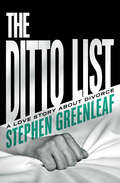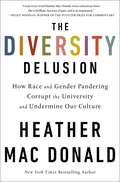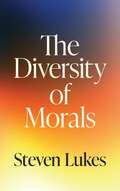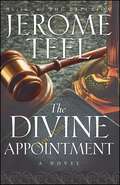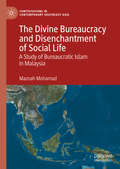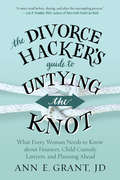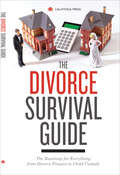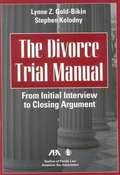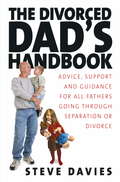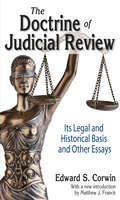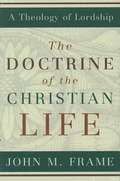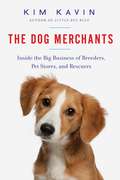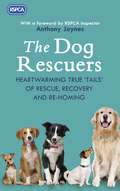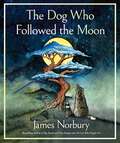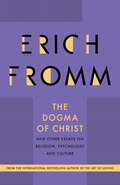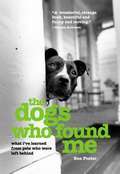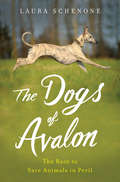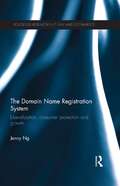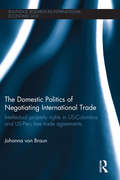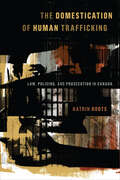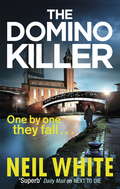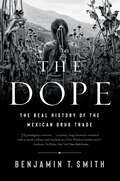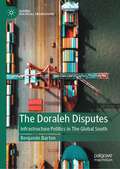- Table View
- List View
The Ditto List
by Stephen GreenleafA slightly sleazy divorce lawyer discovers something strange about himself: a conscience There are seven women in the courtroom, and D. T. Jones loves them all. They are women who married young, have been mistreated, and have no prospects, no hope. For them, Jones will do all he can, which isn&’t much. A cut-rate divorce lawyer, he specializes in default settlements—no alimony, no property, no fight. He&’s not good, but he&’s fast, and his clients ask nothing more. Despite his cynical exterior, Jones considers himself a knight in rusty armor, helping women whom the world has failed. He yearns for a single quest worthy of his talents. He&’ll get three: A battered pregnant woman, a penniless sufferer of multiple sclerosis, and a betrayed housewife all come to Jones begging for his help. Each case is impossible. To take all three could be professional suicide. How could he say no?
The Diversity Delusion: How Race and Gender Pandering Corrupt the University and Undermine Our Culture
by Heather Mac DonaldBy the New York Times bestselling author: a provocative account of the attack on the humanities, the rise of intolerance, and the erosion of serious learningAmerica is in crisis, from the university to the workplace. Toxic ideas first spread by higher education have undermined humanistic values, fueled intolerance, and widened divisions in our larger culture. Chaucer, Shakespeare and Milton? Oppressive. American history? Tyranny. Professors correcting grammar and spelling, or employers hiring by merit? Racist and sexist. Students emerge into the working world believing that human beings are defined by their skin color, gender, and sexual preference, and that oppression based on these characteristics is the American experience. Speech that challenges these campus orthodoxies is silenced with brute force.The Diversity Delusion argues that the root of this problem is the belief in America’s endemic racism and sexism, a belief that has engendered a metastasizing diversity bureaucracy in society and academia. Diversity commissars denounce meritocratic standards as discriminatory, enforce hiring quotas, and teach students and adults alike to think of themselves as perpetual victims. From #MeToo mania that blurs flirtations with criminal acts, to implicit bias and diversity compliance training that sees racism in every interaction, Heather Mac Donald argues that we are creating a nation of narrowed minds, primed for grievance, and that we are putting our competitive edge at risk. But there is hope in the works of authors, composers, and artists who have long inspired the best in us. Compiling the author’s decades of research and writing on the subject, The Diversity Delusion calls for a return to the classical liberal pursuits of open-minded inquiry and expression, by which everyone can discover a common humanity.
The Diversity of Morals
by Steven LukesHow to make sense of the divergence between philosophers&’ quest for a single morality and social scientists&’ assumption that there are multiple moralitiesWhen we speak of morals, what are we speaking of? Is morality singular (as many philosophers tend to assume, even if they don&’t agree on what it is) or are there multiple moralities (which social scientists, notably anthropologists, study)? In The Diversity of Morals, Steven Lukes brings together these differing perspectives. Drawing on philosophy, sociology, social anthropology, psychology, and political theory, Lukes considers what the moral domain includes and what it excludes; how what is moral differs from what is conventional or customary in different contexts; whether morality is unified or a series of fragments; and, if there is a diversity of morals, what that diversity consists of.Lukes looks both ways—toward philosophers&’ quest for a single best answer to the question of morality and toward sociologists&’ and anthropologists&’ assumption that there are several, even many, even very many, answers—to make sense of their divergence. He traces the two approaches back to their beginnings, linking them to the differences between the ideas of David Hume, Johann Gottfried Herder, and Adam Smith. Lukes examines how we went from viewing the social world as &“us&” versus &“them&” to thinking of morality as universal, envisioning shared humanity and the sacredness of the human person, and what prevents this vision from being realized. Considering the breakdown of moral constraints in the perpetration of mass atrocities, Lukes asks if there are phenomena that are beyond moral justification. And he raises this crucial question: in light of the vast variation that history and the ethnographic record display, how wide and how deep is the diversity of morals?
The Divine Appointment
by Jerome Teel"They aren't hiding just one something, but a bunch of somethings..." Jessica Caldwell hates the day she met him, and she hates him even more. But now the two of them will be connected forever... Eli Faulkner is one of the best trial lawyers in Tennessee. It's what he lives for -- righting injustices. When he's called upon to defend Tag Grissom, an arrogant cardiologist accused of murder, he fi nds himself wondering, could this be more than just a case? Holland Fletcher has always wanted to be a true investigative journalist, but he's never really stepped up to the plate. That is, until he receives an anonymous tip and is plunged into a dangerous realm of intrigue and murder that involves not only the Supreme Court, but the entire nation.
The Divine Bureaucracy and Disenchantment of Social Life: A Study of Bureaucratic Islam in Malaysia (Contestations in Contemporary Southeast Asia)
by Maznah MohamadThis book traces the expansion of Islamisation within a modern and plural state such as Malaysia. It elaborates on how elements of theology, sacred space, resources, and their interactivity with secular instruments such as legislative, electoral, and new social technological platforms are all instrumentally employed to consolidate a divine bureaucracy. The book makes the point that religious social movements and political parties are only few of the important agents of Islamisation in society. The other is the modern and secular state structure itself. Weber’s legal rational bureaucracy or Hegel’s ethical bureaucracy predominantly characterises a modern feature of governmentality. In this instance an Islamic bureaucracy is advantageously situated not only within an ambit of modernity and therefore legality, but divinity and therefore sacrality as well. This positioning gives religious state agents more salience than any other form of bureaucracy leading to their unquestioned authority in the current contexts of societies with Muslim majority rule. One of the requisites of this condition is the homogenisation of Islam followed by ring-fencing of its constituents. The latter can involve contestations with women, other genders, ‘secular’ Muslims, non-Muslims as well as dissenting Muslims with their differing truthful ‘Islams’.
The Divorce Hacker's Guide to Untying the Knot: What Every Woman Needs to Know about Finances, Child Custody, Lawyers, and Planning Ahead
by Ann E. GrantThe best guide for protecting yourself through divorce Family law attorney Ann Grant presents the practical information every woman needs to protect herself as she navigates through a divorce. Feelings of loss, grief, and rage are common during divorce. But one of the most debilitating feelings experienced by women going through divorce is paralyzing impotence. Grant will help you take back your power and rights concerning finances, home, children, and work life. With compassion, insight, and tough-minded realism, she breaks down the process and provides step-by-step assessments, checklists, and inspiring stories of successful lives post-divorce. Her goal is to give you insider information that will not only make your divorce “successful” but also establish your life firmly and confidently on a positive, fresh new standing.
The Divorce Survival Guide: The Roadmap for Everything from Divorce Finance to Child Custody
by Calistoga PressAnswer all your pressing divorce questions with The Divorce Survival Guide. Facing a divorce can be overwhelming, as you confront complex questions about everything from finances to child custody to your emotional well-being. The Divorce Survival Guide walks you through every step of the divorce process with straightforward tips, techniques, and checklists. It outlines your legal, parental, and financial rights, and details common scenarios that may arise in the legal proceedings so that you can make informed and thoughtful decisions. Most important, The Divorce Survival Guide helps you through the complex emotional work of divorce, with tips on handling stress, and techniques for protecting and communicating with your children. The Divorce Survival Guide will be your practical guide to the divorce process, with: An easy-to-follow guide to the initial divorce steps, including how to understand divorce laws and your legal rights Information on protecting your finances, such as how to divide your property fairly, protect your credit, and uncover hidden assets A helpful quiz to find out whether you should get an attorney, from the editors of The Divorce Survival Guide Essential information for understanding custody, child support, and how to give your child emotional security Practical techniques for reducing stress, understanding the emotional stages of divorce, and dealing with mutual relationships With The Divorce Survival Guide: The Roadmap for Everything from Divorce Finance to Child Custody, you'll have the invaluable tools you need to make the best financial, practical, and emotional choices throughout your divorce.
The Divorce Trial Manual: From Initial Interview to Closing Argument
by Lynne Z. Gold-Bikin Stephen KolodnyThis book provides a complete overview for family law trial practitioners and helps them to prepare for the trial and in reaching successful settlement negotiations and a satisfactory result.
The Divorced Dads' Handbook: Advice, Support and Guidance for all Fathers Going through Separation or Divorce
by Steve DaviesThis book provides practical hard-to-find help to fathers who are separated from their kids. It covers various relevant areas from legal (UK law) and financial to emotional and recreational. This work is delivered in a down-to-earth and accessible style. Contents: 1. Separation; 2. Seeing your kids:the first few months; 3. Contact arrangements; 4. Court orders: dealing with family courts; 5. Mediation services; 6. Your financial responsibility to your children; 7. Ongoing parenting: become a great dad; 8. Building your own support network; 9. Paternity issues; 10. Parent Alienation Syndrome; Useful contacts; Index.
The Doctrine of Judicial Review: Its Legal and Historical Basis and Other Essays
by Edward S. CorwinThis book, first published in 1914, contains five historical essays. Three of them are on the concept of judicial review, which is defined as the power of a court to review and invalidate unlawful acts by the legislative and executive branches of government. One chapter addresses the historical controversy over states' rights. Another concerns the Pelatiah Webster Myth�the notion that the US Constitution was the work of a single person.In "Marbury v. Madison and the Doctrine of Judicial Review," Edward S. Corwin analyzes the legal source of the power of the Supreme Court to review acts of Congress. "We, the People" examines the rights of states in relation to secession and nullification. "The Pelatiah Webster Myth" demolishes Hannis Taylor's thesis that Webster was the "secret" author of the constitution. "The Dred Scott Decision" considers Chief Justice Taney's argument concerning Scott's title to citizenship under the Constitution. "Some Possibilities in the Way of Treaty-Making" discusses how the US Constitution relates to international treaties.Matthew J. Franck's new introduction to this centennial edition situates Corwin's career in the history of judicial review both as a concept and as a political reality.
The Doctrine of the Christian Life (A Theology of Lordship, Volume #3)
by John M. FrameThe third volume of Frame's Theology of Lordship series, this book focuses on biblical ethics. In an age of ethical relativism and suspicion of authority, how can we know what is good, virtuous, or just? Frame surveys non-Christian ethical traditions before setting forth a solidly Christian ethical method. By clarifying biblical norms, life situations, and personal dimensions, he presents a model for decision making that honors God in all aspects of life. Discussions range from natural law and conflict of duties to detailed explorations of the Ten Commandments in connection with questions surrounding worship, the Sabbath, church and state, respect for life and truth, sexuality, and the relation of Christ to culture.
The Dog Merchants: Inside the Big Business of Breeders, Pet Stores, and Rescuers
by Kim KavinWe love them with all our hearts, but do we really know where our dogs came from? Kim Kavin, author of Little Boy Blue, reveals the complex network behind the $11 billion-a-year business of selling dogs. A must-read for the benefit of all dogs, everywhere. In what promises to become an "Omnivore's Dilemma" for dog lovers--breed devotees and adoption advocates alike--The Dog Merchants is the first book to explain the complex and often surprisingly similar business practices that extend from the American Kennel Club to local shelters, from Westminster champions to dog auctions. Without judging dog lovers of any stripe, The Dog Merchants makes it clear that money spent among these dog merchants has real-world effects on people and canines. Kavin reveals how dog merchants create markets for dogs, often in defiance of the usual rules of supply and demand. She takes an investigative approach and meets breeders and rescuers at all levels, shedding much-needed light on an industry that most people don't even realize is an industry. Kavin's goal is to advance the conversation about how all dogs are treated, from puppy mills to high-kill shelters. She shows that a great deal can be improved by understanding the business practices behind selling dogs of all kinds. Instead of pitting rescue and purebred people against each other, The Dog Merchants shows how all dog lovers can come together, with one voice as consumers, on behalf of all our beloved companions.
The Dog Who Couldn't Wag his Tail
by Linda AdkinsWhen his rescuer saw him on the side of the road, the poor swollen dog, needed a lot of help. He had terrible ear mites, and no hair except for a couple of tufts on his face. The dog could not even wag his tail. But with some kind caring vets and a chance to get better [and] learn a few tricks, "Mighty Mite," a golden retriever mix, was able to make a difference as a blood donor for other animals in need and as a therapy dog. This is his true story.
The Dog Who Followed the Moon
by James NorburyFrom the international bestselling author and illustrator of Big Panda and Tiny Dragon and The Cat Who Taught Zen comes a beautifully illustrated adult fable of a lost young puppy, the old wolf who rescues her, and their journey to follow the moon—with meditations on friendship, connection, and sacrifice.Deep in the mountain forests, a young pup named Amaya wanders lost and alone, until an aging wolf rescues her from a terrifying encounter with his vicious pack. To try and reunite Amaya with her parents, the unlikely pair embark on a journey to follow the moon.Eerie woods, forgotten cities, and other obstacles await Amaya and the Wolf on their adventure. As they make their way through the wilderness, the two learn profound lessons about love, sacrifice, and the importance of embracing change.Featuring stunning artwork from bestselling author and illustrator James Norbury, The Dog Who Followed the Moon is a moving, poignant reflection on love and loss, grief and growth.
The Dogma of Christ: And Other Essays on Religion, Psychology and Culture (Routledge Classics Ser.)
by Erich Fromm&“Fromm&’s developing thought merits the critical attention of all concerned with the human condition and its future.&” —The Washington Post The essays in this fascinating volume examine present-day psychological and cultural problems with the keen insight and humanistic sympathies characteristic of Erich Fromm&’s work.The Dogma of Christ provides some of the sharpest critical insights into how the contemporary world of human destructiveness and violence can no longer separate religion, psychology, and politics. The book brilliantly summarizes Fromm&’s ideas on how culture and society shape our behavior. &“It&’s the new post-religious theme song. The Fromm exhortations are imaginative and he has a definite audience.&” —Kirkus Reviews &“Of all the psychological theorists who have tried to formulate a system better than Freud&’s to approach problems of contemporary life, no one has been more creative or influential than Erich Fromm. He is the most articulate advocate on the role of social forces in molding our character and on our manner of relating to others. This volume is an expansion of his systematic doctrine.&” —Louis L. Lunsky, MD, Archives of Internal Medicine
The Dogs Who Found Me: What I've Learned From Pets Who Were Left Behind
by Ken Foster(From the back cover) Disaster-prone writer and reluctant dog rescuer Ken Foster finds himself adopting an ever-growing collection of stray dogs, from a beagle abandoned in a New York City dog run to a pit bull in a Mississippi truck stop. Their circumstances offer a grounding counterpoint to his own misfortunes: the shock of New YorkCity after 9/11, the evacuation of New Orleans during Hurricane Katrina, and the day his heart nearly stopped for good.
The Dogs of Avalon: The Race to Save Animals in Peril
by Laura SchenoneAfter adopting an Irish sight hound, Laura Schenone discovers a remarkable and little-known fight to gain justice for dogs and for all animals. Greyhounds, bred to be the fastest racing dogs on earth, are streaks of lightning. Beautiful, astonishing creatures, countless numbers of them disappear each year once they can no longer compete and win. The Dogs of Avalon introduces us to the strong-willed Marion Fitzgibbon, born in rural Ireland, where animals are valued only for their utility. But Fitzgibbon believes that suffering is felt by all creatures, and she champions the cause of strays, baffling those around her—including her family—as she and a group of local women rescue any animal in need and taking on increasingly risky missions. When Fitzgibbon becomes head of the Irish Society for the Prevention of Cruelty to Animals and focuses on the cause of the greyhound, she faces an entrenched racing industry protected by money and power. She joins forces with an American greyhound activist, a foxhunter’s wife, a British lady, and an influential German animal rescuer to create an international network to find these animals homes, confront the racing industry, and provide safe havens where animals can live in peace. The Dogs of Avalon brings forward the people on the other side of the tracks—Irish Travellers (a people whose Celtic history goes back centuries), dogmen who hope to win big—together with a host of animals on two continents—circus tigers in Ireland, wild monkeys in the Yucatan, dolphins in a marine animal park in Florida, and one very special Irish sight hound in New Jersey named Lily. In this potent David and Goliath story, Schenone’s journey helps us understand our deep connection to animals and gives us inspiration in the form of the unforgettable Fitzgibbon, who grapples with compassion and activism and shows the difference we are all capable of making in the world.
The Domain Name Registration System: Liberalisation, Consumer Protection and Growth (Routledge Research in Information Technology and E-Commerce Law)
by Jenny NgThis book offers a comparative analysis of the domain name registration systems utililsed in Australia and the United Kingdom. Taking an international perspective, the author analyses the global trends and dynamics of the domain name registration systems and explores the advantages and disadvantages of restrictive and less restrictive systems by addressing issues of consumer protection. The book examines the regulatory frameworks in the restrictive and unrestrictive registration systems and considers recent developments in this area. Jenny Ng also examines the legal and economic implications of these regulatory frameworks, drawing upon economic theory, regulatory and systems theory as well as applying rigorous legal analysis. In doing so, this work proposes ways in which such systems could be better designed to reflect the needs of the specific circumstances in individual jurisdictions. The Domain Name Registration System will be of particular interest to academics and students of IT law and e-commerce.
The Domestic Politics of Negotiating International Trade: Intellectual Property Rights in US-Colombia and US-Peru Free Trade Agreements (Routledge Research in International Economic Law)
by Johanna von BraunThe Domestic Politics of International Trade considers the issues surrounding intellectual property rights in international trade negotiations in order to examine the challenges posed to domestic policy-makers by the increasingly broad nature of Free Trade Agreements (FTAs). Throughout the book the author demonstrates the importance of domestic politics in understanding the nature and outcome of international negotiations, particularly as they relate to international economic diplomacy. The book looks in detail at the intellectual property negotiations which formed part of the US-Peru and US-Colombia Free Trade Agreements and analyses the extent to which public health authorities and other parties affected by the increased levels of intellectual property protection were integrated into the negotiation process. The book then juxtaposes these findings with an analysis of the domestic origins of US negotiation objectives in the field of intellectual property, paying particular attention to the role of the private sector in the development of these objectives. Based on a substantial amount of empirical research, including approximately 100 interviews with negotiators, capital based policy-makers, private sector representatives, and civil society organisations in Lima, Bogotá and Washington, DC, this book offers a rare account of different stakeholders’ perceptions of the FTA negotiation process. Ultimately, the book succeeds in integrating the study of domestic politics with that of international negotiations. This book will be of particular interest to academics as well as practitioners and students in the fields of international law, economic law, intellectual property, political economy, international relations, comparative politics and government.
The Domestication of Human Trafficking: Law, Policing, and Prosecution in Canada
by Katrin RootsHuman trafficking has emerged as one of the top international and domestic policy concerns, and is well covered and often sensationalized by the media. The nature of the topic combined with various international pressures has resulted in an array of government-led mandates to combat the issue. The Domestication of Human Trafficking examines Canada’s criminal justice approaches to human trafficking, with a particular focus on the ways in which the intersecting factors of race, class, gender, and sexuality impact practice. Using a wide range of qualitative and empirically grounded research methods, including extensive analysis of court documents, trial transcripts, and interviews with criminal justice actors, this book contributes to much-needed research that examines, specifies, and sometimes complicates the narratives of how trafficking works as a criminal offence. The Domestication of Human Trafficking turns our attention to the ways in which the offence of human trafficking is made on the front lines of criminal justice efforts in Canada.
The Domino Killer
by Neil WhiteWhen a man is found beaten to death in a local Manchester park, Detective Constable Sam Parker is one of the investigating officers. Sam swiftly identifies the victim, but what at first looks like an open and shut case quickly starts to unravel when he realises that the victim's fingerprints were found on a knife at another crime scene, a month earlier.Meanwhile, Sam's brother, Joe - a criminal defence lawyer in the city - comes face to face with a man whose very presence sends shockwaves through his life. Joe must confront the demons of his past as he struggles to come to terms with the darkness that this man represents.Before long, Joe and Sam are in way over their heads, both sucked into a terrifying game of cat-and-mouse that threatens to change their lives for ever...'Authenticity reeks from every page...hypnotic, troubling crime writing with a superb villain and a distinctive atmosphere.' Daily Mail on Next to Die
The Domino Killer
by Neil WhiteWhen a man is found beaten to death in a local Manchester park, Detective Constable Sam Parker is one of the investigating officers. Sam swiftly identifies the victim, but what at first looks like an open and shut case quickly starts to unravel when he realises that the victim's fingerprints were found on a knife at another crime scene, a month earlier.Meanwhile, Sam's brother, Joe - a criminal defence lawyer in the city - comes face to face with a man whose very presence sends shockwaves through his life. Joe must confront the demons of his past as he struggles to come to terms with the darkness that this man represents.Before long, Joe and Sam are in way over their heads, both sucked into a terrifying game of cat-and-mouse that threatens to change their lives for ever...'Authenticity reeks from every page...hypnotic, troubling crime writing with a superb villain and a distinctive atmosphere.' Daily Mail on Next to Die
The Dope: The Real History Of The Mexican Drug Trade
by Benjamin T. SmithA myth-busting, 100-year history of the Mexican drug trade that reveals how an industry founded by farmers and village healers became dominated by cartels and kingpins. The Mexican drug trade has inspired prejudiced narratives of a war between north and south, white and brown; between noble cops and vicious kingpins, corrupt politicians and powerful cartels. In this first comprehensive history of the trade, historian Benjamin T. Smith tells the real story of how and why this one-peaceful industry turned violent. He uncovers its origins and explains how this illicit business essentially built modern Mexico, affecting everything from agriculture to medicine to economics—and the country’s all-important relationship with the United States. Drawing on unprecedented archival research; leaked DEA, Mexican law enforcement, and cartel documents; and dozens of harrowing interviews, Smith tells a thrilling story brimming with vivid characters—from Ignacia “La Nacha” Jasso, “queen pin” of Ciudad Juárez, to Dr. Leopoldo Salazar Viniegra, the crusading physician who argued that marijuana was harmless and tried to decriminalize morphine, to Harry Anslinger, the Machiavellian founder of the American Federal Bureau of Narcotics, who drummed up racist drug panics to increase his budget. Smith also profiles everyday agricultural workers, whose stories reveal both the economic benefits and the human cost of the trade. The Dope contains many surprising conclusions about drug use and the failure of drug enforcement, all backed by new research and data. Smith explains the complicated dynamics that drive the current drug war violence, probes the U.S.-backed policies that have inflamed the carnage, and explores corruption on both sides of the border. A dark morality tale about the American hunger for intoxication and the necessities of human survival, The Dope is essential for understanding the violence in the drug war and how decades-old myths shape Mexico in the American imagination today.
The Doraleh Disputes: Infrastructure Politics in The Global South (Global Political Transitions)
by Benjamin BartonThis book focuses on underexploited data drawn from various legal disputes over the Doraleh Container Terminal in order to paint a portrait of SSC when it comes to infrastructure financing and construction in Africa as provided both by the UAE and China. By producing a detailed account of the drivers behind these disputes as well as the broader political outcomes they have generated, this study provides invaluable conceptual and empirical lessons on the contemporary meaning of SSC. In doing so, it helps readers garner a more acute understanding of the role played by Global South states and the private sector (SOEs) against the backdrop of SSC.
